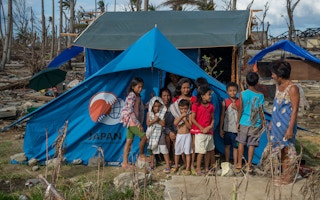Nearly 15 million people worldwide—approximately the population of Cambodia—were forced from their homes in 2015 by weather-related disasters, including violent storms, floods and landslides.
As climate change intensifies, those numbers will rise. Not everyone will end up resettling elsewhere, but a large, undetermined number of displaced people are already becoming environmental migrants, defined by the International Organization for Migration as people who are obliged or choose to leave home due to sudden or progressive environmental changes that adversely affect their lives.
Climate change is one factor in the rising numbers of these displaced people, but the associated crisis is where many of these people live. Up to 650 million people live in areas that will be submerged or exposed to chronic flooding by 2100. The majority of people facing such threats make their home in Asia and the Pacific, the world’s most disaster-prone region, which is acutely exposed to the impacts of climate change.
Sea level rise, one of the most destructive climate change impacts, poses an irreversible threat to coastal communities and island states. Nine of the 10 countries with the largest number of vulnerable people living in low-lying areas are in Asia. In the Pacific, climate change threatens to literally redraw the map.
The threat is real
Entire countries and cultures on the small states in the world’s largest body of water confront an uncertain future. Australian climate researchers have identified five small reef islands in the Solomon Islands that have vanished over the past seven decades, and six other islands that have lost much of their land to the sea.
Receding shorelines have wiped out two villages, forcing residents to higher ground. The isolated nation of Tuvalu, just 2m above sea level, appears to be the country most threatened by climate change. Peak tides have reached as high as 3.4 meters.
The international community has awoken to the human toll of environment-related displacement, and to the likelihood that climate change will exacerbate these conditions. In 2015, governmental delegations from 109 countries endorsed the Nansen Protection Agenda for people displaced by disaster and climate change, and the Platform for Disaster Displacement has been established to implement this agenda.
More than 20 events discussing the link between climate change and migration were held during the COP22 meeting last November in Marrakech, Morocco.
The 2015 Paris Agreement on climate change called for the creation of a task force to develop ways of avoiding or minimizing human displacement caused by climate change. This was a significant advance, and it is important that the task force be formed, funded, and become active as soon as possible.
It has been given less than two years to deliver recommendations applicable at subnational, national, regional, and international levels, and to identify legal, policy and institutional challenges, as well as good practices and lessons learned.
Countries in Asia and the Pacific are already bolstering their defenses against environmental threats, and preparing for displacement in areas that are no longer safe to inhabit. The People’s Republic of China, Papua New Guinea, and Viet Nam have relocated communities that face flood risks.
Bangladesh, long accustomed to cyclones and extensive flooding, has signed an agreement with the Netherlands to reclaim land by using sediment flowing through the country’s rivers, creating resettlement areas for people displaced by river erosion.
In Mangoroco, a village in Iloilo province in the Philippines, a sea wall built by residents saved many lives when Typhoon Haiyan hit the area in 2013. Kiribati has adopted a ‘migration with dignity’ policy to create opportunities for those who wish to emigrate abroad now and in the near future.
“
With planning and investment, some migration can be averted or postponed. In other cases, migration should be promoted as a practical way of adapting before it’s too late.
Adapt before it’s too late
A 2012 ADB study recommended that countries conduct national assessments of natural disaster risks, calling for strengthened disaster risk management through better early disaster warning systems and improved design of post-disaster sheltering plans.
There’s also a need for social protection and jobs for those who remain behind in vulnerable areas. Governments can support development initiatives driven by the communities themselves, as well as skills training and alternative livelihood programs.
They can invest in climate-resilient sustainable infrastructure and basic services in migrant-receiving cities, using hazard maps to guide future resettlement plans, and consulting with local communities in the construction of storm-resistant homes.
Environmental migration should be systematically addressed in strategy, policy, and planning documents on climate change, such as nationally determined contributions under the COP process, as well as in country development plans and disaster risk reduction strategies.
With planning and investment, some migration can be averted or postponed. In other cases, migration should be promoted as a practical way of adapting before it’s too late.
What should be avoided, however, is inertia. Better policies, strong leadership, rigorous scientific research, and international cooperation will help vulnerable communities make informed choices about their future – rather than let climate change decide for them.
Bart Edes is Advisor, Sustainable Development and Climate Change Department; Head, Knowledge Sharing and Services Center, Asian Development Bank. This blog first appeared as an article in Asian Geographic magazine and is republished from the ADB blog.











